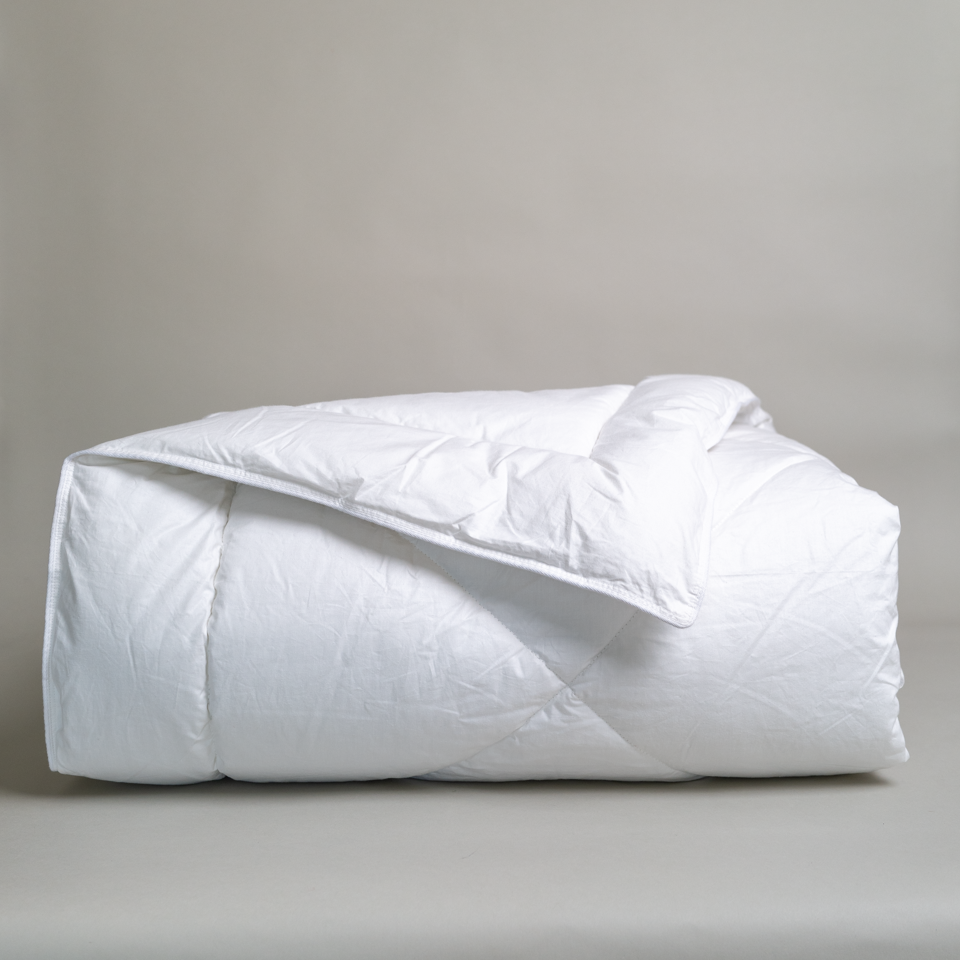How to Make Your Pillows and Bedding Last
Once you have made an investment in beautiful bedding, you will want to enjoy it for as long as possible. Clean, cared for, and hygienic bedding also makes for healthy sleep. Here are tips for keeping your pillows and bedding clean so you can have a great night’s sleep!™ These tips are also available in our Product Care FAQs. Remember to check the tags on your bedding items before any laundering.
Mattress Pads
You may not see your mattress pad, but it protects your mattress and takes the brunt of any spills or accidents. It should be cleaned when it becomes soiled or periodically to remove the accumulation of dander you might not be able to see. Machine wash in cold or warm water with mild detergent. Tumble dry on low to medium heat. Do not use fabric softener during the wash cycle or dryer sheets while drying as they may damage and/or remove the waterproof layer of the pad.
Feather Beds
Feather beds should be washed upon soiling or in the event of a buildup of moisture in your room. Keeping down and feather bedding clean and thoroughly dry will prevent the buildup of dust or mold. When it is time to launder your feather bed, we suggest washing in a front-load washer in cold or warm water up to 40°C (104°F). Use a front load dryer and include three fresh tennis balls or a dryer ball to agitate the fill. You may have to reposition the feather bed in the dryer as it begins to dry. It is very important that you dry your feather bed thoroughly to avoid mildew. This may take several hours.
While you can wash and dry your feather bed at home, we strongly recommend professional laundering if you do not have a sufficiently large machine to properly wash and tumble dry or if the tag recommends professional cleaning. You should always follow the laundering instructions on your feather bed. Dust mites are killed at around 57°C (134.6°F), which is typically the medium heat setting of a dryer.
Linens
Wash your linens before placing them on your bed for the first time. Warm water and mild detergent are typically recommended, but you should read the manufacturers’ directions first. How you wash them will affect their appearance and lifespan, as well as your health. Separate darks and lights and do not over bleach or use harsh soaps and chemicals. Wash linens separately from other laundry, especially terry products, which can be rough and will require different drying times. Cotton linens can typically withstand hotter wash temperatures, which will kill most germs and dust mites.
Ironing is not necessary, but it will kill any remaining dust mites, and sheets that have been ironed look hotel-bed ready. Linen and silk sheets require special care. Check out our Care instructions in our FAQ section.
We recommend you follow the lead of luxury hotels and institute a FIFO (first in, first out) system with your linens. This will allow linens to rest between launderings.
Comforters
Although down comforters can be more expensive than other types of comforters, with proper care, a down comforter will last for years, meaning it will save you money over other products that do not exhibit the same durability and require replacement more frequently. As mentioned above, comforters or duvets are intended to be used with covers. We encourage you to use comforter covers to create the most hygienic bed and to protect your investment. It is easier to remove a cover for washing than it is to wash the comforter. A cover will also allow you to get the customized look that matches your décor.
Comforters should be washed upon soiling or in the event of a buildup of moisture in your room. Down and feather comforters and Aquaplush® Hypoallergenic Polyester down alternative comforters should be laundered if there are visible stains or noticeable odors. Keeping down bedding clean and thoroughly dry will prevent the buildup of dust or mold. When it is time to launder your comforters, we suggest washing most brands of natural comforter in a front-load washer in warm water. While you can wash and dry your comforters at home with the proper machines, we strongly recommend professional laundering if you do not as a large machine is required to properly tumble dry. If machine washing, do so in cold or warm water on a gentle cycle with a mild detergent in a washing machine large enough to allow movement in the drum. Do not bleach.
Tumble dry on low in a front load dryer until thoroughly dried to kill dust mites and to prevent mold growth. Down and feather comforters may be dried along with dryer balls or clean tennis balls in order to open up the down and create maximum fluff. You may have to reposition the comforter in the dryer as it begins to dry. It is very important that you dry your comforters thoroughly to avoid mildew. Dust mites are killed at around 57°C (134.6°F), which is typically the medium heat setting of a dryer.
Pillows
Our mantra: Down Etc highly recommends the consistent use of zippered pillow protectors to protect against sweat and spills and to extend the life of the pillows you love. It is easier to launder a removeable pillow protector with the rest of your linens than it is to launder a pillow.
Down and feather pillows and Aquaplush® Hypoallergenic Polyester down alternative pillows should be laundered if there are visible stains or noticeable odors or in the event of a buildup of moisture in your room. Keeping pillows clean and thoroughly dry will prevent the buildup of dust or mold.
While in theory you can wash and dry your pillows at home, if you do not have a large enough front-loading washer and dryer, we strongly recommend professional laundering as a large machine is required to properly wash and tumble dry. You should always follow the laundering instructions on your pillow. If machine washing, do so in cold or warm water on a gentle cycle with a mild detergent in a washing machine large enough to allow movement in the drum. Do not bleach. Tumble dry on low in a front load dryer until thoroughly dried to kill dust mites and to prevent mold growth.
Down and feather pillows may be dried along with dryer balls or clean tennis balls in order to open up the down and create maximum fluff. Use a front-load dryer and include three fresh tennis balls or a dryer ball to agitate the fill. You may have to reposition the pillow in the dryer as it begins to dry. It is very important that you dry your pillows thoroughly to avoid mildew. This may take some time. Dust mites are killed at around 57°C (134.6°F), which is typically the medium heat setting of a dryer.
Pillows consistently enclosed in zippered pillow protectors should still be laundered at least every 6 months. Even if down and feather pillows do not need laundering, they will benefit from being placed in the dryer for 3 to 5 minutes on low heat to open the down thereby fluffing and refreshing the pillows.
Pillows take a beating whether they are supporting your head or propping your back. As a result, the lifespan of pillows is much shorter than the lifespan of comforters. Pillows at the end of their lifespans can no longer give your head and neck the support they require. If you bend your pillow in half and it does not bounce back, it might be time to find a new pillow.






